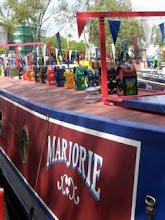Monday morning held the promise of participating in an activity that might not appeal to everyone. With my love of ancient history, walking on the beach, and unusual adventures, the invitation to go “mudlarking” on the Thames was too intriguing to pass up. I’ve always wanted to join in on an archeological dig, and this was a good opportunity to practice what I call “archeology by intuition”, asking myself where I should look, dig, or scavenge based on my sixth sense of where things would be found.
Mudlarking is essentially scavenging or “beachcombing” along the banks of the Thames at low tide. I did not realize how extreme the tides were in the river. One can see from the bridges and embankments that the river’s flow sometimes slows down or stops altogether, but I never realized that large swatches of riverbank become exposed during the extreme low tides.
My mudlarking invitation was issued by StitcherJane, at whose home we meet on Thursdays for Stitchery Group. She has an avid interest in historical London, and informed us that we would find bits of artifacts from hundreds of years ago. We rendezvoused at Cannon Street station so that we would walk down the hill on Cousin’s Lane and wind up at the Thames between Southwark Bridge and London Bridge. There were some very slimy steps leading down to what she referred to as the “foreshore”.
I had been duly warned to dress warmly, as it can be quite windy at the level of the river. Indeed, when I woke up on Monday morning, it was overcast and 39 degrees F. I made sure I was wearing layers and a waterproof jacket for the inevitable rain. I had also donned my brand-new Wellies, which are waterproof boots. StitcherJane had also recommended bringing germ-proof latex gloves. In addition to those, my backpack also contained: plastic bags for storing the “haul”, germicidal hand-gel, a towel, in case anyone got wet, a warm wool hat, warm gloves to wear underneath the industrial-strength latex cleaning gloves, my camera, keys, and Oyster (travel) card.
Why all the Universal precautions, you may ask? StitcherJane had warned me that not only was the river water not necessarily clean, but we might encounter ground or objects which had been contaminated by rat urine. I know that there are rats near the river, having had a run-in with a large one while staying in the Globe View apartments last year, but I never really thought about their urine and the diseases it could spread. Apparantly there was just an unfortunate incident of a woman dying from Weil’s Disease after attempting to free a rat from her bird feeder. I made sure I was wearing old clothes that could be chucked out in case of contamination.
We descended the algae- and mud-slimed steps down from the embankment onto a thirty-foot wide strip of what appeared to be stones. It stretched for about a quarter-mile downstream from our entry point. It was immediately clear that the hat and gloves would be necessary to combat the cold wind down at river level.
I started picking my way along the “beach”. On closer inspection, many of the brown “stones” that littered the beach were actually animals’ bones. We were at the site of an abattoir, a slaughterhouse that had been in use for centuries. When they were done slaughtering the animals, they had just chucked the bones and other waste into the river. The area has not been used for that purpose for decades, so it was unbelievable to me that waste from that era had not been completely washed away. I could identify jawbones, ribs, bits of broken bone from both cattle and sheep.
The next item I recognized were chunks of flint in all shapes and sizes. Flint is the stone used by ancient people for sharp objects such as arrowheads, knives, and as a fire-starter stone. I had never seen in in situ in such a large quantity before. There were all kinds of twisted blobby shapes looking almost like black glass, with a chalky covering on them. Many of them were tiny bits, but there were large heavy ones with holes in them, holes caused by the softer chalk being worn away by the elements.
There were also a lot of fist-sized soft white lumps, which were actually chalk.
StitcherJane had told us that we might find bits of pottery from centuries ago, so I concentrated on finding these smaller pieces. I found that by bending a little at the waist, it was quite easy to spot these bits of pottery. Most were an inch or two in diameter, and clearly had been part of plates, bowls, mugs and pots. The easiest to spot were the blue-and-white porcelain transferware, embellished with floral and country motifs. Underneath the mud and algae, these showed an even crackled pattern that showed their age to be between a hundred and two hundred years old. There were also less pretty, but probably more valuable bits of “slipware”, hand-thrown earthenware with a slip-coat of thin mud applied to it. These were in earthenware colors, and some had been glazed with darker glaze. These were from the seventeenth century and beyond. Two pieces of earthenware with dark green glaze were later identified as being of Tudor origin by StitcherJane.
Also easy to spot were tiny white tubes about an inch or so in length. I was told these were pipe stems that dated back to when the New World crop of tobacco arrived in the British Isles. They were lying amongst the bones and stones in a very casual way, as if they had just been spat there by a smoking sailor.
Further picking amongst the rubble showed a couple of pieces of fluted limestone, which had probably ornamented a building, another piece of limestone carved “18xx” in inch-high letters, an iron ring, and broken bricks with part of the maker’s name stamped into them. Our fearless leader informed us that some of what we were finding showed evidence of charing. Whenever there was a fire, such as the “Great Fire” of 1666, the remaining rubble was just shoveled down to the edge of the river and tipped in. She then mentioned that all of the terra-cotta slightly-curved broken slabs containing one hole were actually Roman roof tiles. That’s right, Roman Roof Tiles. Tiles from 46 AD and up. That’s 46 AD, folks. Broken bits of Roman roof tiles just laying there today on the shores of the Thames. They have so many of them at the Museum of London that they don’t even care about those that are still there. I presume that new loads of antique rubbish get revealed with each low tide, but I will have to go back to confirm this. I was absolutely enchanted by the tiles. I am particularly interested in the era that includes the arrival of the Roman conquerors in England, and the clash of cultures and religious beliefs that must have occurred at the time. Holding the roof tiles in my gloved hands really gave me a thrill. I kept pouncing on the best ones and loading them into a flimsy plastic bag. Finally, my bags of loot filled the backpack and I knew I wouldn’t be able to carry any more.
How are regular people allowed to take this stuff, you may ask. Stitcher Jane informed me that one only needs to get a Mudlarking permit if one is going to either use a metal detector, or dig down more than 3 inches. I was just using a plastic picnic knife to turn over one object at a time, and wasn’t really digging at all. The knife was being used just to protect me from anything sharp that I might encounter, like a needle or cut glass. I didn’t run into anything of that sort at all.
We slowly picked our way down the “beach” of stones, bones, china, and roof tiles. Most of the ladies were concentrating their efforts down near the edge of the water, but I figured that the oldest items would be up closest to the embankment and near the steps, which would have been closest to the edges of the old Roman settlement. In the 19th or 20th century the Cannon Street railroad bridge had it’s foundation laid there, which probably stirred up several layers of previous cultures.
Further down we encountered a gush of fresh water coming out of a pipe which stretched 12 feet high up the embankment. It looked like pretty clean water, not like water from a sewer pipe or storm drain would. I “tuned in” with my super-powers, and got two bits of information. The first was “Minerva”, which told me that it probably was a spring used by the Romans (and had probably been a pagan spring before that). The second bit was that the water was the “Walbrook”, a small stream that is now underground (brook from the Roman Wall) whose source is near a church called St. Stephen, Walbrook. I think that church was an early Sir Christopher Wren practice run-up for St. Paul’s which is quite nearby. I’ll have to check in my books.
We noticed that the area around the pipe outlet was discolored a pale tan. All of the bricks, tiles and bones looked like they had mineral deposits on them. The water, although completely clear, had a faint smell of either sulphur or some other natural substance dissolved within it. Again, more research is needed. We were indeed directly downhill from the street on which St. Stephen, Walbrook church is located, so I’ll stick with that idea as the source of the water.
Around noon we were too tired and cold to continue, so we all tromped back up the slimy steps with our loot, de-gloved, and headed back to the Cannon Street Underground station. On the way up the hill, we noticed that signs on some of the buildings indicated the ancient homes of some of the guilds that would have sprung up near the slaughterhouse: The tanner's guild, the dyer's guild, and the chandler's guild (making candles from tallow, which is animal fat).
Once I got the loot home, I rinsed it in scalding hot water and then soaked it for hours in a strong bleach solution. It was then left on a rack to air-dry for several days. But what is it for? You may be asking. A large chunk of limestone and cement from the foundations of a building (bigger than a brick, smaller than a breadbox) will be our new doorstop for the French door in the reception room. The Roman roof tiles will make fine paperweight/pen stands and might be given as gifts to those who will appreciate them. The porcelain bits and pipe stems will make some nifty dada-ist “found art” installations and murals. Of course, anything not used otherwise will be used as ballast for the flat in case of a great flood or tsunami.
I can’t remember the last time I had so much free fun. I'm looking forward to the next conveniently-timed fair weather low tide.
Love and Light

- BlogMama
- London, NW8, United Kingdom
- A "recovering academic", I have left the world of research and teaching Psychology. My current focus is on offering hypnotherapy, Reiki, and spiritual support for clients and hospice residents. I like to express myself through the arts, especially drama (the quirky-comic relief part),stand-up comedy, painting, and the fiber arts.
Subscribe to:
Post Comments (Atom)









No comments:
Post a Comment